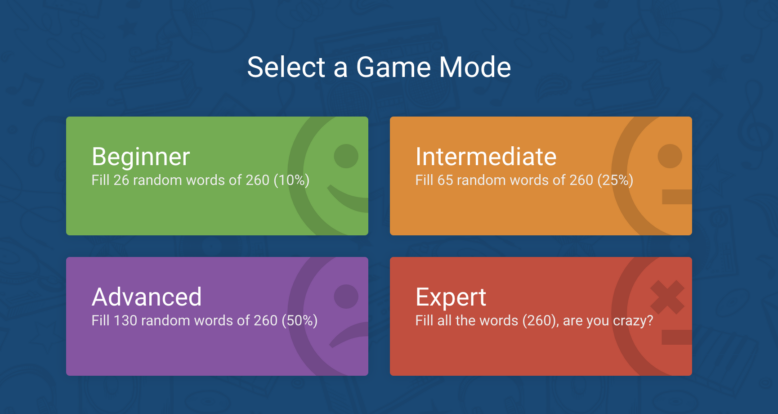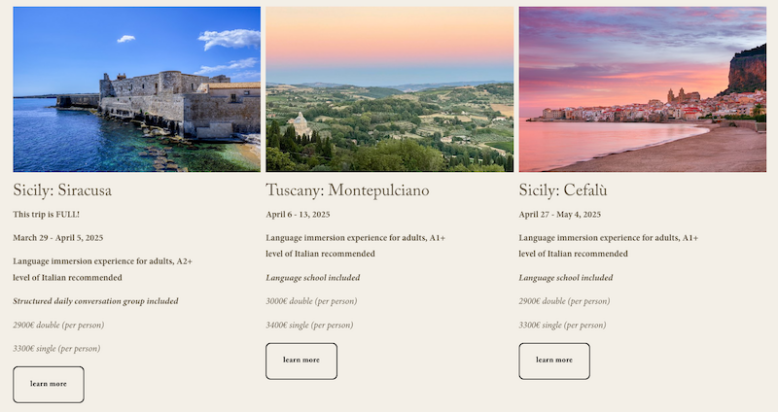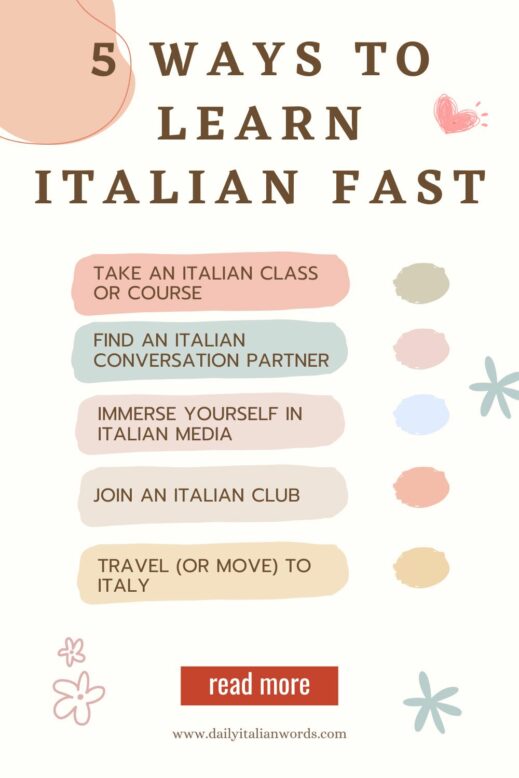How can I learn Italian language easily and quickly? This is a question we regularly receive on our blog, and one that merits a fair answer.
The truth is that learning a language, like any other skill, takes time, practice and perseverance. In fact, it has been estimated that in order to learn a Romance language like Italian to proficiency, the average English speaker would need to spend around 600 hours to reach basic fluency in a classroom setting. Granted, there are savants out there who seem to absorb languages with very little effort, but the vast majority of us do not fall into this category.
That being said, there are various methods we can use to teach ourselves Italian and see satisfactory results in a relatively short period of time. Below you will find five methods that I personally recommend based on my own experience as a successful language learner.
Ethics statement: Within the article, there are affiliate links. If you buy something after clicking the link, we will receive a small commission. To know more about our ethics, you can visit our full disclosure page. Thank you!

1. Take an Italian class or course
Let’s begin with the most traditional method of learning a language: taking a class or course.
Although not my preferred method, taking a language course can give you the basic tools you need to construct grammatically correct sentences and establish your vocabulary. Not to mention that you will have the ongoing support of your teacher and classmates.

Courses also hold you accountable – not only do you have deadlines to meet, but you also have a financial stake in succeeding. So if you are the kind of person who thrives under the pressure to perform well academically (like yours truly), taking an Italian course could be a great way to hit the ground running.
There are various courses available at the high school and university / college level, but if you prefer something tailored to your needs, I highly recommend checking out italki. As I explain in my full review, italki is a platform where you can take online lessons with qualified tutors at a very affordable price.
Of course, if you’d rather work at your own pace, and have the required discipline to follow through with your studies, there are numerous free and paid online courses you can take to improve your Italian including:
- Rocket Italian (affiliate link)
- ItalianPod101 (affiliate link)
- Duolingo
What’s more, there are numerous YouTube channels you can follow which share weekly lessons about the Italian language. Our favourites are LearnAmo, Podcast Italiano, Learn Italian with Lucrezia and My Italian Circle as they all feature a nice mix of grammar explanations, practical exercises, topics dedicated to specific vocabulary and expressions, and more.
Finally, a quick and easy way to absorb bite-sized amounts of Italian per day, without the pressure of having to follow a full lesson, is to follow a few good Italian tutors on social media. Here are the accounts we highly recommend:
- Italian Matters – TikTok | Instagram | Facebook
- Dite! Italian with Nicco – Instagram | Facebook | Twitter
- Italian with Davide – Instagram | Facebook
- Italiano con Saretta – Instagram
- Italian with Grace – TikTok | Instagram | Facebook
Helpful tip: When I start studying a new language, a supporting app I use all the time is Anki, which is a virtual flashcard program that helps me to review new words and expressions. It’s completely free on desktop and Android, whereas on Apple devices, you need to pay a small fee.
2. Find an Italian conversation partner
This brings me to my second method for learning Italian effectively, which is finding a conversation partner.
The most affordable route is the language exchange, or in other words, an arrangement between yourself and an Italian person interested in practising their English skills. Because it is an equal exchange of services, money is left out of the equation. You can find conversation partners like this on apps such as HelloTalk or Tandem. My suggestion is to find someone whose level of English is comparable to your Italian, so that one person does not dominate or take advantage of the other.

Then there is the social media option. I personally use WhatsApp and Facebook groups a lot to converse with likeminded Italian people. In fact, I am even part of a group of Italian and English speaking moms who help each other with their target language. Within minutes of sending a text asking a question, I am guaranteed to receive a response from someone in the group!
Of course, there is always the option to pay someone to converse with you, and once again, italki (affiliate link) is the perfect platform for this.
3. Immerse yourself in Italian media
One of the best ways to learn Italian on your own at home is to immerse yourself in all sorts of Italian media, from movies and songs to books, podcasts and the radio playing in the background while you make dinner. This method is especially useful if you don’t have someone to practise speaking with on a daily basis. Media won’t replace real live conversation, but it is certainly the next best thing.
Watching movies and TV shows in Italian – be they original productions or dubbed into Italian – is effective because you can expose yourself to authentic dialogue spoken at a native speed. And if you don’t understand something, you can always rewind and listen to the dialogue again. This method is effective even at the beginner stage because you can expose your ear to the sounds of the language. We would always suggest activating the Italian subtitles, never the English ones, as doing so will allow you to follow along with the dialogue while picking up new words and expressions.

A really useful app that is designed to help you improve your vocabulary by watching films and TV shows is called LingoPie (affiliate link). All shows come with two sets of subtitles (Italian and English), and all you have to do to get an instant translation is click on a word. In short, the more you watch, the more you learn! But of course, you can always stick to more traditional platforms like Netflix, Amazon Prime (affiliate link) or Disney, all of which have a wide array of Italian content.
Learning the lyrics to your favourite Italian songs and singing along karaoke-style is another really fun way to learn Italian by yourself. Not only will you pick up lots of new words, but you will also improve your Italian pronunciation and accent. After all, who could pass up the opportunity to belt out classics like O Sole Mio or Volare, Nel Blu Dipinto di Blu?
An app I recently discovered that you can use to practise the lyrics of your favourite Italian songs is LyricsTraining. Simply pick a song you like, select the “game mode” (beginner to advanced), and type in the missing lyrics as the song plays.

And speaking of music, let’s not forget about the humble radio. When I’m at home, pottering around the house doing chores or cooking, I always listen to Radio Italia, one of the only radio stations that plays nothing but Italian music. The great thing about the radio is that you can listen to a mix of songs, commercials and presenters talking about various topics. I’d suggest downloading it as an app on your phone, as the desktop version is only available in Italy. Alternatively you can listen to podcasts in Italian, which are a great option when you’re out driving or travelling on public transport. A couple of my favourites include Coffee Break Italian and News in Slow Italian.

Finally we come to books. I realise that books may not be the easiest way to start learning Italian as a beginner, since there will initially be many words to look up. But once you’ve reached a lower intermediate level, there is no reason you can’t start reading simple stories or even children’s books. My favourite app for reading books in Italian is called LingQ – simply upload an ebook or article to the app, and tap on unfamiliar vocabulary as you read. These words will be saved into a file that you can review later on.
4. Join an Italian club
A fantastic way to learn conversational Italian and make new friends who are as passionate about the language as you are is to join an Italian club in your area.
I’ve never actually used this strategy for Italian, but when I was studying Japanese at university, I regularly attended the hour-long conversation club that took place every Friday morning in the lunch hall, free of charge. I also hosted a Welsh conversation club for a couple of years, at which I met many people who were enthusiastic about helping me improve my Welsh.

Even if you aren’t attending university, most big cities have at least one club dedicated to Italian language and culture. For example, in Toronto there is the The Toronto Italian Connection, a “group of Italian-Canadians, Italians-living-in-Canada, and Italian-speaking persons who meet regularly in various Italian restaurants in Toronto to enjoy Italian cuisine, communicate in Italian, discuss Italian films and novels, and enjoy each others’ company.”
5. Travel (or move) to Italy
The most obvious way to learn Italian quickly and easily is to move to Italy, or at the very least, travel there for an extended period. I know this option isn’t feasible for many of us, but there is no getting around that the full immersion experience can take you from zero to conversational in a mere matter of months.
If committing to a long stay isn’t possible, a structured immersion experience in Italy can be the next best thing. Our partner, Vero Viaggio, specialises in small-group Italian language immersion tours that go beyond traditional tourism. These carefully curated week-long experiences combine cultural exploration with real-world language practice, helping participants gain confidence in speaking Italian while engaging with locals in authentic settings. Whether you’re strolling through a bustling market, sharing a meal with native speakers, or participating in hands-on activities, these programs provide a rich, immersive environment to accelerate your learning. (You can find out more about their upcoming trips here!)

If you have just graduated, or are a university student taking a gap year, one of the most affordable ways to live in Italy on a budget is to become an au pair. Au pair is another term for a “live-in babysitter” whose job is to look after the family’s children for a set number of hours per day and, in some cases, teach them your native language (in our case, English). This is exactly what I did for the first two years I lived in Turin. The three children I looked after didn’t speak any English when I first moved in, so for pure survival purposes, I had to learn some Italian in order to figure out their needs. In many ways, it was the perfect language exchange!

Someone in their late 20s or older may prefer to attend a language school in Italy – I attended L’Italiano Porticando in Turin – or simply travel the country and interact with the locals. A word of warning though: if you stick to the touristy areas of Italy, most people will probably try to practise their English on you!
Check out these 27 essential phrases for tourists visiting Italy!
Bonus: Talk to yourself
A very effective, and frequently underrated way of improving your spoken abilities in your second language, especially if you are very shy or have no one to talk to, is to talk to yourself. This method is known in the language mentoring industry as Self-Talk.
By talking to yourself, you can improve your pronunciation, consolidate new vocabulary, and get into the routine of using the language on a daily basis. Doing so will also help you get a clearer idea of where your strengths and weaknesses lie. And the real bonus is that no one will judge you if you don’t say something correctly, or if you repeat the same phrase to yourself ten times over!
A fresh approach, akin to Self-Talk, involves using AI chatbots like the impressive LangAI for Italian practice. Engage in a conversation with the bot as if you were chatting with a person, and it will provide you with both written and audio responses!
Did you enjoy these tips for learning Italian quickly and easily? Are there any tips you think I might have missed? If so, please leave me a comment below!


Heather Broster is a graduate with honours in linguistics from the University of Western Ontario. She is an aspiring polyglot, proficient in English and Italian, as well as Japanese, Welsh, and French to varying degrees of fluency. Originally from Toronto, Heather has resided in various countries, notably Italy for a period of six years. Her primary focus lies in the fields of language acquisition, education, and bilingual instruction.


